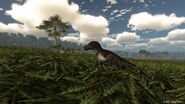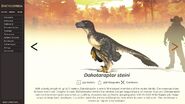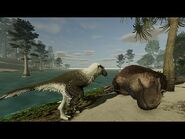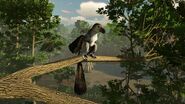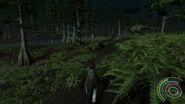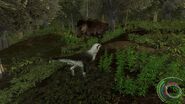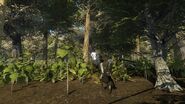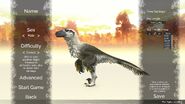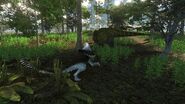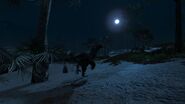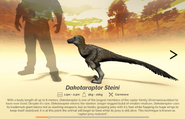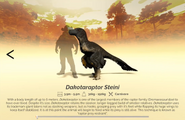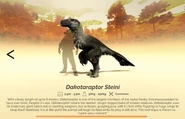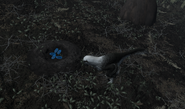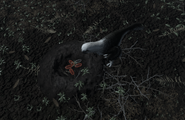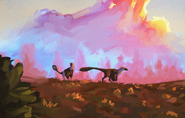"With a body length of up to 6 meters, Dakotaraptor is one of the largest members of the raptor family (Dromaeosauridae) to have ever lived. Despite it's size, Dakotaraptor retains the sleeker, longer-legged build of smaller relatives. Dakotaraptor uses it's trademark giant talons not as slashing weapons, but as hooks, grasping prey with it's feet while flapping its huge wings to keep itself stabilized. It is at this point the animal will begin to feed while its prey is still alive. This technique is known as "raptor prey restraint"."
―Saurian encyclopedia
Dakotaraptor is an extinct genus of possible chimeric dromaeosaurid known from partial skeletons unearthed in South Dakota, USA. Its fossils have been found in the Maastrichtian-age Hell Creek Formation, dated to the very end of the Cretaceous period, making it one of the last surviving dromeosaurids known. It is currently a playable dinosaur in Saurian.
Information[]
A common misconception is that Dakotaraptor has beaten Utahraptor as the largest dromaeosaurid, but this is untrue. Utahraptor has a max estimation of 7 metres (23 ft) in length and 500 kg (1,100 lbs) in weight, while Dakotaraptor was 5.5 metres (19.6 ft) in length and 453 kg (1,000 lbs) in weight but were on a similar scale.
The fossils discovered in South Dakota show tiny “quill knobs” on the lower arm bones, suggesting Dakotaraptor had feathers all over the body, including wings on its arms.
A study of the known fossils of Dakotaraptor show that in body proportions this genus was actually more like genera such as Deinonychus and Dromaeosaurus than to those of Utahraptor, making a direct link between Dakotaraptor and Utahraptor unlikely. Curiously, Dakotaraptor was more gracile, and had a lighter build more akin to those of these smaller dromaeosaurids than to Utahraptor. This is also consistent with the time that spans between Utahraptor and Dakotaraptor. It has been considered as being a closer relative to the Campanian Dromaeosaurus (having been classified as its sister taxon, therefore making them most closely related to each other), so Dakotaraptor's large size is only an example of convergent evolution with Utahraptor. More recent analysis, by Hartman et al, defy the original views that Dakotaraptor was a dromaeosaurine, and cladistic analysis go to the notion that it was instead an unusual large unenlagiine, which would make it the first North American member of the Unenlagiinae. This analysis is still under reviewing, but it is to note the position of Dakotaraptor as a dromaeosaur in general is still very solid. An even more recent phylogenetic analysis recovers Dakotaraptor as a dromaeosaurine, though its questionable chimeric nature is raised to the debate.
Dakotaraptor is the second dromaeosaurid dinosaur known from the Hell Creek Formation, with the first being the much smaller Acheroraptor. The only other mainly predatory dinosaur known to have been around at the same time and location, while being bigger than Dakotaraptor, is the mighty Tyrannosaurus. Possible prey dinosaurs for Dakotaraptor could include anything from ceratopsian dinosaurs such as Triceratops, ankylosaurs and nodosaurs such as Ankylosaurus and Denversaurus, pachycephalosaurs such as Pachycephalosaurus, and hadrosaurs and thescelosaurs such as Anatosaurus and Thescelosaurus.
A recent study seemed to show that the wishbones of Dakotaraptor may actually belong to an extinct genus of turtles: Axestemys splendida. If this was true, Dakotaraptor would've no longer have been a valid genus, and merely a chimaera between a theropod dinosaur and a turtle. However, this is dubious at best, as there may be new papers confirming that Dakotaraptor was indeed a valid genus. The wishbones could easily be removed from the type fossil definition, maintaining the validity of the genus. Additionally, it has been proposed the leg bones attributed to the holotype might even belong to an oviraptorosaur instead, likely Anzu, which raise the question about the chimeric nature of the holotype. Other independent analysis, specifically proposed by Andrea Cau, put forth suspicions that some of the caudal material might in fact belong to ornithomimid material, and that the large ungual of Dakotaraptor might instead be a Tyrannosaurus claw. There may still be some material that is most probably still worth being attributed to a large dromaeosaur in the Dakotaraptor holotype, but given the dubiousness of the validity of various aspects of the holotype, Dakotaraptor itself risks to become a invalid and dubious genus in its entirety.
Two different proposed morphs, a robust and gracile one, were present in the fossil material. Studies show that both of these Dakotaraptor were seemingly adults. Reasons for this disparity of shape can vary from individual variety of pathologies (malnourishment or a deficiency during growth may have caused the gracile variety), while another explanation is that it may have been sexual dimorphism, which could suggest that males and females were different from each other in terms of shape. If the latter is true, however, there is still no clue to which is the male or the female.
In Saurian[]

Adult Dakotaraptor close to a Pachycephalosaurus kill
Dakotaraptor gameplay[]
"Dakotaraptor are not good parents. They will tolerate you as a hatchling but once you become a juvenile they will start to see you as food."
― Saurian Dakotaraptor hatchling gameplay guide, referencing Dakotaraptor's poor parental care
"Dakotaraptor can take down larger prey with Raptor Prey Restraint. Jump onto an animal to initiate RPR. Once mounted, flap to maintain your balance by clicking RMB and damage your prey by clicking LMB."
― Saurian Dakotaraptor juvenile gameplay guide, teaching how to practice RPR.
Dakotaraptor is the first playable dinosaur to have been introduced in the game. Currently in the game, the Dakotaraptor is able to practice RPR (Raptor Prey Restraint) to restrain prey that are about it's size, or larger. Young Dakotaraptor are also able to climb trees and glide with their pennaceous wings, a useful tool to escape from predators and cover large distances without risking aggression from other animals. Dakotaraptor are very fast runners, which makes evading most threats much more easy.
Dakotaraptor are stated as having very bad parental care. Apparently both the male and the female form a mating bond, but they don't seem to feed their babies, as they only tolerate their presence. The parents will hunt for food, while the babies will only follow them for protection and subsistence. The parents will only tolerate them until they are juveniles, and by that time they will start to see them as food and competition. Dakotaraptor gameplay must be seen as a individual gameplay at first, to which the hatchling will have to learn how to survive alone way before their parents rejection. The player's parents are a fine source of nourishment, once they hunt something big enough to leave some food behind, or when they die. The parents will often steal food that was caught by the player, to emphasize their lack of parental care.
Dakotaraptor are depicted as cannibal creatures. Players that attempt to hunt another of the same kind, should target animals of the same size or smaller, as each stage of development has an increase in health, bite damage and stamina.
Hatchlings will start with their parents and hatchling gameplay is particularly difficult, as the parents protection is uncommon, your predators are abundant and your prey choices are limited. Hatchlings hunt small animals like Chamops, Didelphodon, Lepisosteus and ornithurans, and are very vulnerable to any predator. Basilemys is also a possible prey item by this stage, as it does not run away, and its an easy meal, as long as the player is persistent enough in its biting. Hatchling Triceratops might be a potential meal, but one must be careful if they are surrounded by more members of their kind. Hatchlings can climb trees to avoid ground-dwelling carnivores. The player is an hatchling from age 0-1.
Juveniles have an increase in stamina and durability. Although they pretty much hunt the same thing as hatchlings, the player can try and take down an Acheroraptor, Pectinodon or a Thescelosaurus, the latter of which are advised to hunt as an older juvenile, using RPR, which starts being used by this stage. The player is therefore much more adapted to dodge dangers. Climbing mechanics are improved by the ability of gliding, as their wings are successfully developed. The player is a juvenile from age 1-3.
Subadults are nearly the top predator they will be in adulthood. As they reach sexual maturity, subadults are able to take down a myriad of other animals with ease, like Acheroraptor, Pectinodon, Thescelosaurus, Champsosaurus and Palaeosaniwa, the latter must be done with care, as it is a venomous animal. The player loses the ability to glide or climb trees, but RPR is now an excellent tactic of killing prey. An ambitious player can attempt to take down juvenile Triceratops, Pachycephalosaurus or ornithomimids, but it is still hard, being easier as it grows older. The player is a subadult from age 3-6.
Adults are the oldest you can get, morphologically. In this stage, RPR is amazingly perfected and can be used to take down Pachycephalosaurus and ornithomimids with some ease. The player is an adult from age 6-11. Once the player survives to age 11, they will become a super-adult, with an increase in stamina, health and durability. Super-adults, superficially, don't look much different from fresh adults, but they have slightly bigger claws, older, more ruffed feathers and a generalized bulkiness. Once in this stage, the player can take down crocodylomorphs with more ease, if it manages to avoid their bite, as well as attempt to take down previously impossible prey, like Triceratops, Denversaurus, Ankylosaurus and Anatosaurus, but it is still very hard. Dakotaraptor engage in mated pairs, and their courtship is consisted by short wing and tail displays. The nest of the Dakotaraptor is a simple dirt mound and the eggs are colored in a bright blue. One of the adults is tasked to sit over the nest, to keep the eggs warm, before they hatch.

A mature Dakotaraptor in its environment.
The coloration of Dakotaraptor changes as it grows, but throughout its life it is fully feathered, except for its snout and toe tips. As a fully grown adult, its feather coloration is black, white and grey, along with yellow along the bottom of its feet. Males and females have no sexual dimorphism in the game.
Triceratops gameplay[]
Dakotaraptor are seen as predators of young Triceratops. As hatchling, well grown adult and subadult Dakotaraptor are predators to be avoided, and you must take the safety of the herd to avoid being hunted by one. Juvenile Triceratops are substantially larger and may be able to kill a fully grown Dakotaraptor if lucky, but they must still be seen with caution, at least in the early parts of this life stage. Dakotaraptor are able to RPR the player. As subadult and adult Triceratops, Dakotaraptor are largely not a threat. Triceratops eggs are vulnerable to predation by Dakotaraptor.
Gallery[]
For a more complete gallery, visit Dakotaraptor/Gallery



